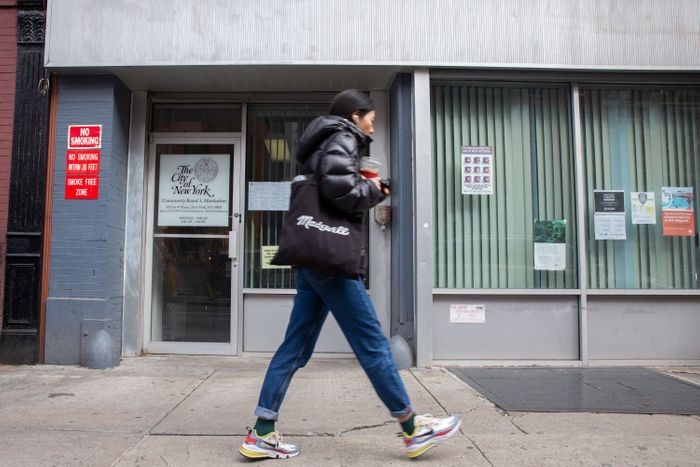By Rachel Holliday Smith and Ann Choi, THE CITY

This story was originally published on Feb. 10, 2020 by THE CITY.
As Manhattan collects applications for a new round of community board members, surveys show how the current crop falls short of resembling the borough.
Overall, board members are older than the borough’s population, homeowners hold a disproportionately high number of seats and Hispanic people are underrepresented.
Only one of 12 boards, the Upper East Side’s Community Board 8, reported a Hispanic membership that matched its district’s population. There, 12% of board members identified as Hispanic in a mostly white district where 9.5% of people are Hispanic, according to Census data.
At the 11 other boards — including the one that covers heavily Dominican Washington Heights and Inwood — Hispanic people were underrepresented by as much as 19 percentage points.
“When it comes to Latinos, we’re underrepresented in almost every situation,” said Deputy Borough President Aldrin Bonilla. “I’m racking my brain to figure out why we’re having such a difficult time.”
A Manhattan Breakdown
The picture of the boards comes from self-reported demographic data collected from members of Manhattan’s dozen boards, where volunteers weigh in on everything from zoning proposals to street redesigns.
Last year for the first time, all five boroughs were mandated by a 2018 change to the city charter to compile and report information race, ethnicity, sex and age as voluntarily reported by members of all 59 community boards. (Staten Island failed to do so, but after THE CITY’s reporting, the borough president vowed to collect the information.)
The same charter change also dictated that community board will face term limits that go into effect starting in 2027, a measure intended to infuse boards with new blood.
Nominations for half of a board’s 50 seats come from local City Council members, and final appointment decisions come from each board’s borough president.
THE CITY’s analysis last month found that boards citywide tend to skew male, while some match the local population more closely than others.
Manhattan Borough President Gale Brewer’s office has tracked board demographic data for five years — well before the new charter rule — and releases the most thorough information of any borough on board membership.
In the last half-decade, Bonilla, who oversees the collection and compiling of that information, has witnessed a lot of changes. For instance, he’s seen many more young people join the boards — thanks to targeted recruiting on social media and a rule change that allowed teens as young as 16 to join, he told THE CITY.
Ethnic Disparities Persist
But some categories, he said, have remained stubbornly low.
Even at Community Board 12 — which encompasses Washington Heights and Inwood, where a majority of people are Hispanic — the number of Hispanic board members fell short. There, 51% of board members reported they are Hispanic in a neighborhood where 69% of people are Hispanic, census data shows.
Eleazar Bueno, the newly elected chair of CB12, said for many Hispanic people, joining a board is “a matter of time.”
“Usually boards have retirees, homeowners — people that are financially secure,” said Bueno, who owns several empanada shops. “When you have a job, or when you have kids and a family, you don’t have the 10, 20 hours a week to voluntarily give.”
Targeting communities not well-represented at boards is key to attracting more members, Bueno said. At CB12, he is aiming to do more outreach on social media, and pushing to livestream meetings.
“A lot of the community boards are perceived — not that that’s how they are — to be private clubs,” he added.
Bridging the Age Gap
Manhattan community board members also tend to be older than the residents they represent.
Only about one-third of the borough’s population is over 50. On Manhattan’s boards, half of the members are in that age group.
It’s an issue that Michelle Kuppersmith, a member of the Lower East Side’s Community Board 3, has recently tried to tackle.
Working with the demographic data released by Brewer’s office, she and fellow CB3 member Joe Kerns created a website, as part of a fellowship with the political group Arena, that analyzes membership as well as vacancies on boards.
The aim of the project, Kuppersmith said, was to encourage more people to apply to their local boards all over the city — especially young people.
“Different age groups in this city experience life differently,” she said. In particular, she sees young voices as critical in conversations around housing.

“Millennials, my age group, are less likely to own a home than their parents’ generation,” said Kuppersmith, 32. “People who are searching for apartments every year and paying higher and higher rents might have a different perspective on the housing situation and land use.”
Bonilla says boards have become much younger in the five years his office has tracked the data. Overall, it’s been “the biggest shift” of all the demographic categories, he said.
Angel Mescain has noticed that change on his board. He’s been the district manager for Manhattan Community Board 11 in East Harlem for about 10 years. When he started, the board was noticeably older.
“Through retirement, or attrition, or, you know, interest from the young folks — it’s definitely mixed,” he said. “It’s a lot different than what it was.”
Now, CB11 has just 13 members, or about 30%, who are older than 50. The biggest group are people in their 30s, and the board even had a couple of teens join in recent years.
“The younger folks are going to be more interested in things that can be considered change,” he said. “For me, it makes the conversations much more interesting.”
A Skewed Housing Mix
East Harlem’s CB11 bucks the trend in another important way: Its members live in a much more diverse collection of places than in other Manhattan community districts.
The borough is the only one in New York that collects data on what type of housing board members live in. The categories include co-ops, condos, market-rate rentals, rent-stabilized apartments, single-family homes, Mitchell Lama complexes and public housing.
Using that data, analysis by THE CITY found that renters comprise about 54% of Manhattan community board members. But renters make up about 75% of Manhattan’s population, according to the 2017 NYC Housing and Vacancy Survey.
That’s not surprising to CB3’s Kuppersmith.
“If you are constantly chasing a market-rate rental that you can afford, you might not be able to stay in the neighborhood where the community board is long-term,” she said. Homeowners, on the other hand, tend to remain put.
Meanwhile, many boards do not have a single member who lives in public housing, or have just one.
CB11 is an exception, with seven out of 44 members reporting they live in New York City Housing Authority units. In Manhattan, one in 11 residents live in NYCHA, or about 9% of the population.
Not all districts have a lot of public housing. In Manhattan, NYCHA complexes are primarily concentrated in Upper Manhattan and the Lower East Side, where the number of community board members who live in public housing is also elevated.
‘Speaking for Your Neighbors’
But Bonilla isn’t satisfied.
“In those areas where there’s public housing, we have to do a much better job to get NYCHA representation,” he said.
In a typical year, Bonilla says Manhattan boards will have between 70 and 80 vacancies and get hundreds of applications. In the year after the 2016 election, the board received about 1,100 applications — a record.
Boards make no laws and weigh in on municipal planning decisions only in an advisory capacity. To Mescain of CB11, their role is critical for “putting issues out there in the public discourse.”
“In the absence of community boards, you don’t get as many of those things on the table,” he said. “None of it is super exciting. But it’s important.”
For Kuppersmith, the value of being on a board is interacting directly with city agencies, having a chance to influence your local Council member and amplifying the voice of your block.
“You’re not speaking just for yourself. You’re speaking for your neighbors,” she said. “And that’s a powerful thing.”
HOW TO APPLY
Interested in applying to a community board? The last day to apply in Manhattan is Friday, Feb. 14. The application is here.
Here are the deadlines in other boroughs:
• Brooklyn: Last day is Friday, Feb. 14. Application is here.
• Staten Island: No deadline, applications accepted all year. Here’s the link.
• The Bronx: The deadline has passed. Applications closed Friday, Feb. 7.
• Queens: The deadline has passed. Applications closed Friday, Jan. 31.
Each borough’s application is different, but here’s what to expect:
• You have to live, work in or have a professional or other significant interest in the board’s district.
• Most board applications ask whether you’ve attended a community board meeting before. That experience is encouraged.
• Get ready to disclose a lot of information, kind of like a job application. Job history, references — Manhattan’s application even asks for a resume.
• Think about how much time you can dedicate to the board. It’s reasonable to assume you will be required to attend two or three meetings a month. Be ready for questions about that.
• Keep this in mind: All applicants are subject to the state Freedom of Information Law, which means your application could be made public.
This story was originally published by THE CITY, an independent, nonprofit news organization dedicated to hard-hitting reporting that serves the people of New York.



































